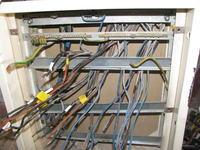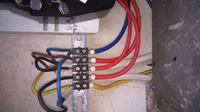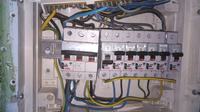Hello,
I will mention right away that I have very little knowledge of electricity, which is enough to connect a socket at home or lighting. Going to the topic, recently in my box outside, the wires were mixed up ("someone" tried to connect a power welder there, some wire fell out of him and he did not know where to put it and everything fell down). Well, there are three phases coming from the pole, one output phase and grounding. There are two houses in the yard - one has always been attached to one phase and ours to two. And here the problem begins, you know (I hope I am thinking correctly) I connect two output cables from both houses to the cable going to the pole and the ground to ground. In this way, we are left with three wires - two to one house and one to the other. And here the stairs begin, so we have strength in the house, that is, three wires should go to us (this is also the case in the home box), not two, as shown by the box outside. The problem is that the electricity in our house is only downstairs - there is no upstairs (I suspect it's a phase). Help, how can I connect these wires so that everything is fine - in the box there are two phases - black cable and brown, and only black to the other house? (when an electrician connected it, he said that the current is not the same in every phase? What is it about?).
I will mention right away that I have very little knowledge of electricity, which is enough to connect a socket at home or lighting. Going to the topic, recently in my box outside, the wires were mixed up ("someone" tried to connect a power welder there, some wire fell out of him and he did not know where to put it and everything fell down). Well, there are three phases coming from the pole, one output phase and grounding. There are two houses in the yard - one has always been attached to one phase and ours to two. And here the problem begins, you know (I hope I am thinking correctly) I connect two output cables from both houses to the cable going to the pole and the ground to ground. In this way, we are left with three wires - two to one house and one to the other. And here the stairs begin, so we have strength in the house, that is, three wires should go to us (this is also the case in the home box), not two, as shown by the box outside. The problem is that the electricity in our house is only downstairs - there is no upstairs (I suspect it's a phase). Help, how can I connect these wires so that everything is fine - in the box there are two phases - black cable and brown, and only black to the other house? (when an electrician connected it, he said that the current is not the same in every phase? What is it about?).





